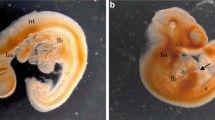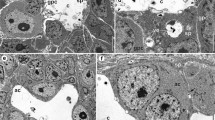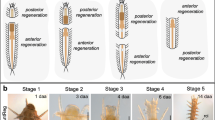Summary
In the present paper the ultrastructure of the subcuticulare zone of the tegument ofFasciola hepatica and the distribution of thimidine-H3 for establishing the localization of DNA-synthesis in the tegument was studied.
There were two types of subcuticular cells: 1) non-differentiated cells with presence of incorporated labelled thimidine in nuclei presented by DNA non-stable macromolecules, and 2) differentiated or definitive subcuticular cells without aggregates of silver grains.
The results showed a high level of DNA replication leading to mitotic activity of the non-differentiated cells and absence of mitotic activity in the definitive cells.
There was a morphological similarity between non-differentiated cells and the cells from the medular zone, supposing a relationship in their origin.
Similar content being viewed by others
References
Caro, L., Tubergen, R. van, Kold, J.: High-resolution autoradiography. J. Cell Biol.15, 173–188 (1962)
Dawes, B.: Maintenance in vitro ofFasciola hepatica L. Nature (Lond.)174, 654–655 (1954).
Lumsden, L: Cytological studies on the absorbtive surfaces of Cestodes. Dissertation, Houston, Texas (1965)
Palade, G.: The endoplasmic reticulum. J. biophys. biochem. Cytol.2, 85–98, Suppl. (1956).
Porter, K.: The submicroscopic structure of protoplasma. Harvey Lect.51, 175–228 (1957)
Porter, K.: The endoplsmic reticulum: Some current interpretations of its forms and functions. In: Biological structure and function, pp. 127–155, New York: Acad. Press 1961
Waddington, C.: New patterns in genetics and development, pp. 217–285. New York: Columbia Univ. Press (1962)
Warner, J., Rich, A., Hall, C.: Electron microscope studies of ribosomal clusters synthesizing hemoglobin. Science 1399–1403 (1963)
Weiss, J.: The ergastoplsm. Its fine structure and relation to protein synthesis as studies with the electron microscope in the pancreas of the Swiss albino mouse. J. exp. Med.98, 607–618 (1953)
Author information
Authors and Affiliations
Rights and permissions
About this article
Cite this article
Poljakova-Krusteva, O., Donchev, N., Gorchilova, L. et al. Origin, structure and function of subcuticular cells ofFasciola hepatica . Z. F. Parasitenkunde 50, 285–291 (1976). https://doi.org/10.1007/BF02462973
Received:
Issue Date:
DOI: https://doi.org/10.1007/BF02462973




